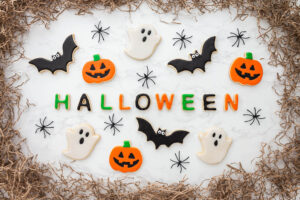
Halloween has a long and complicated history. It is an amalgamation of several fall festivals, dating back thousands of years. A day in which the veil between the living and the dead was believed to be at its thinnest, a harvest festival, and the day that signified the end of summer. No matter the reason, people connected as communities—they traveled from house to house, gathered around bonfires, told fortunes, and participated in costumed parades.
Looking for a coworking space that embraces community and collaboration? Book a tour of Cohere Coworking today!
The Fort Collins community has a long history of celebrating the fall season and Halloween. Cohere, as a friendship-based coworking space, is all about community. It’s one of the core principles of coworking after all. Not only do we congregate to collaborate about work and encourage one another to be wildly productive, but we also get together to enjoy food, fun, and one another’s company.
Many Coherians have plans for the first major holiday of the fall season, including going out on the town in both time-honored and contemporary costumes, semi-quiet evenings passing out candy, and festive dance parties. On October 25th, Coherians will gather for one of our many creative community events—one based on the traditions of Halloween, including fortune telling and caramel apples.
Here are a few tidbits about the history of some of our most treasured Halloween traditions.
Fortune Telling
Ghosts and spirits are a well-known aspect of the Halloween holiday season, as tradition says that the barriers between life and death are thinnest on the night of Halloween. This belief also led to the idea that spirits from other realms would be better able to communicate with us during that time, and fortune-tellers were consulted at these times, often providing people comfort for the long, dark winter ahead. By the 19th century, divination rituals and games had mostly become centered around love and marriage.
Apples
Apples are an enduring and adaptable fruit that often grow well into the fall season. They can be made into breads, pies, added to meat dishes, or simply eaten raw. They were also at the center of many of the divination methods practiced around Halloween, especially those in the 18th and 19th centuries believed to reveal someone’s future spouse or true love. Bobbing for apples was frequently used as one of these divination games. In some traditions, the first person to catch an apple was said to be the next to marry, while in others initials were carved in the apples before placing them in the bucket or barrel.
Candied apples were developed in the early 1900s, and quickly became a favorite treat to serve at fall carnivals or hand out to trick or treaters. The first caramel apple was introduced due to an excess of caramel candies left over after Halloween in the 1950s. They were developed by an enterprising Kraft foods employee named Dan Walker who decided to use excess caramels in place of the candy.
Costumes and Parades
Costumes and costumed parades were also related to the preponderance of ghosts and goblins said to walk among the living on Halloween and the festivals it was drawn from. Depending on the lore of the area, costumes were meant to confuse the spirits, either into thinking the wearer was one of them, to frighten them off, or to keep the wearer from being mistaken for a spirit. While modern day parades are celebratory showcases of creativity, in some ancient villages, costumed people formed parades to protect the town from harm by leading away wayward spirits.
Jack-o’-Lanterns
Carved pumpkins are one of the most iconic of the modern Halloween symbols, but the original Jack-O-Lanterns, designed to frighten away evil spirits, were typically made from hollowed out turnips and beets. Pumpkins, originally cultivated by Native Americans, were brought to Europe from the New World in the fifteenth or sixteenth century.
These large gourds became popular worldwide for their size, variability, and ability to last long after they were harvested. They proved much easier to hollow out and carve than turnips and beets and soon replaced these as the foundation of most Jack-O-Lanterns. Pumpkin weighing contests are also popular this time of year, as are pumpkin related foods such as pumpkin pie, pumpkin bread, and roasted pumpkin seeds.
